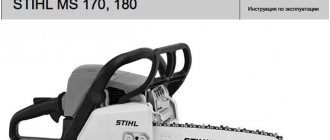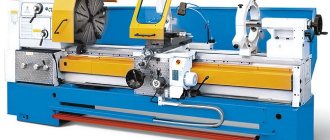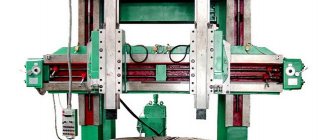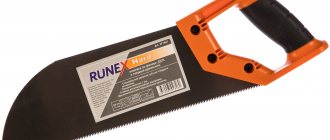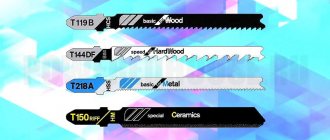A jigsaw is a universal device designed for shaped sawing of various materials. The device easily copes with wooden, plastic, tile and even metal products. You can understand how to use a jigsaw by studying in detail the operational and technical features of the tool.
Depending on the area of application, jigsaws are divided into two main classes - household and professional. Regardless of the type, the design of the tool is equipped with a saw mounted in a special frame.
For home use, small devices for cutting materials are used. These jigsaws can be manually or electrically controlled. Each type of tool has its own technical and design characteristics.
Manual
This tool is of the simplest type. It consists of a frame, a saw blade with clamps and a handle. A manual jigsaw is used mainly for small jobs that require a certain precision of cutting.
The bottom tool allows you to perform artistic cutting of the material. But using it requires patience and skill. The sawing speed of a manual device is low, so it is not practical to use it for large volumes.
Electric
A jigsaw powered by an electrical network is considered the most convenient tool. It allows you to quickly and efficiently cut any material. The depth of the cut mainly depends on the power of the device. For modern devices, this figure can range from 200 to 900 watts.
Electric jigsaw 620 Watt
Low-power jigsaws are suitable for household use. They have a relatively low cost and do an excellent job of sawing wood products up to a depth of 50 millimeters, and metal ones - 23 millimeters. More complex work requires the use of tools with the highest technical parameters.
Safety instructions when cutting with a jigsaw
INSTRUCTIONS No.
SAFETY WHEN CUTTING WITH A JIGSAW
It is allowed to work only with a working jigsaw that ensures reliable and correct fastening of the file.
The jigsaw handle should not have cracks or knots.
Sawing is performed on special tables. Tables must be level and smooth.
When sawing, a straight sitting posture is used.
The main danger when working with a jigsaw is injury to your hands as a result of the blade breaking. The file should be moved from top to bottom evenly, without distortions, with slight pressure on the metal.
Safety regulations
1. Work with a jigsaw and awl with securely fastened and working handles.
2. Securely attach the sawing table to the workbench.
3. Securely secure the file in the jigsaw frame.
4. Do not make sudden movements with a jigsaw when cutting, do not bend low over the workpiece.
Safety Basics:
Use a jigsaw and awl with securely fastened and working handles.
Securely attach the sawing table to the workbench.
Securely secure the file in the jigsaw frame.
Do not make sudden movements with the jigsaw when cutting, do not bend low over the workpiece.
1. When working with a jigsaw, you need to sit upright, half-sided towards the sawing table.
2. Securely attach the sawing table to the workbench.
3. Securely secure the file in the jigsaw frame.
4. Work with a jigsaw and awl with securely fastened and working handles.
5. When cutting, you should turn the plywood, not the jigsaw.
6. Do not make sudden movements with a jigsaw when cutting.
7. The file should be moved from top to bottom evenly, without distortions, with slight pressure.
8. Do not lean low over the workpiece.
- all materials
- Articles
- Scientific works
- Video lessons
- Presentations
- Notes
- Tests
- Work programs
- Other methodological materials
- Kireev Andrey PetrovichWrite 15242 09/20/2017
Material number: DB-696951
- Technology
- 5th grade
- Articles
- 20.09.2017 182
- 20.09.2017 184
- 20.09.2017 150
- 20.09.2017 365
- 20.09.2017 358
- 20.09.2017 609
- 20.09.2017 1765
- 20.09.2017 743
Didn't find what you were looking for?
You might be interested in these courses:
Leave your comment
Log in to ask questions.
Tyumen universities will take receipts from teachers if they refuse vaccination
Reading time: 1 minute
Russia has proposed issuing certificates to a number of schoolchildren for courses to prepare for the Unified State Exam
Reading time: 1 minute
Specialists in the field of pedagogy are in high demand in Russia
Reading time: 1 minute
The Russian Federation proposed introducing an education certificate for large families
Reading time: 1 minute
St. Petersburg schoolgirl scored 300 points on the Unified State Exam
Reading time: 1 minute
Participants will be able to take the Unified State Exam in six subjects during the reserve period of June 28
Reading time: 3 minutes
Gift certificates
Responsibility for resolving any controversial issues regarding the materials themselves and their contents is taken by the users who posted the material on the site. However, the site administration is ready to provide all possible support in resolving any issues related to the work and content of the site. If you notice that materials are being used illegally on this site, please notify the site administration using the feedback form.
All materials posted on the site were created by the authors of the site or posted by users of the site and are presented on the site for informational purposes only. Copyrights for materials belong to their legal authors. Partial or complete copying of site materials without written permission from the site administration is prohibited! The opinion of the administration may not coincide with the point of view of the authors.
Sawing technology
Preparation
When we cut out plywood with a jigsaw, the quality of the finished product largely depends on how responsibly we approached the preparation process.
To avoid incidents during work, you need to spend just a few minutes:
- We inspect the plywood intended for work for damage and peeling of the veneer.
- We check the quality of drying by making a test cut.
- We attach the template printed on the printer to the plywood and secure it with tape or push pins.
- Simple shapes can be transferred to plywood by piercing, leaving awl marks on the material.
Copying the drawing
For clarity, we paint over with a pencil those places on the workpiece that must be removed after cutting. It is better to do this immediately after translating the template, since it will be more difficult to understand the interweaving of lines later.
Basic Operations
So, the preparation is complete, and you can begin your first attempts to cut something out of plywood with your own hands. Of course, if you have never picked up a jigsaw before, then it is worth practicing on simple products before starting a large-scale project. Furniture work using a jigsaw
The work begins with cutting out the outline of the workpiece, after which internal cuts are made. To make a through hole, first drill the plywood with a drill, and only then insert the jigsaw blade.
Below we will describe the sequence of performing basic operations using a hand jigsaw. Using an electric or band saw has its own nuances, but once you master the basics, you will not have any difficulties when working with more advanced equipment. Straight cut
The simplest operation is cutting in a straight line.
The instructions for this operation are as follows:
- We insert the jigsaw file into the drilled hole so that the teeth are directed towards the handle.
- We stretch the canvas so that it does not vibrate during operation, and fix it with a screw.
- We place the workpiece on the workbench, press it with our left hand to the sawing table and gradually begin to saw through.
- When cutting a straight line, move the jigsaw up and down, gradually feeding the workpiece under the saw.
- Control of the straightness of the cut can be ensured by placing a guide bar on the workbench.
Tool position when cutting
Figure cutting is more complex, and you should start it only when you have fully mastered straight cutting:
- We fix the jigsaw file in the same way as in the previous case.
- We lay the workpiece with a clearly drawn line on the workbench.
- We saw from top to bottom, feeding the plywood with our left hand so that the blade does not go beyond the line.
- When the file moves in relation to the template line, we stop moving with our left hand until the file begins to move freely. After this, we adjust the position of the plywood and continue working.
All elements are cut out using this principle, including obtuse corners. But you shouldn’t cut out an acute angle by turning the workpiece, since there is a high risk of the final fragment breaking off. In this case, two slits should be made, connecting them at the top of the corner. We process the edge of the workpiece with a file
After cutting out all the elements, the workpiece must be processed with a file, since even the most careful work does not allow making a product with perfectly smooth edges. Using wood files, we carefully polish the outer and inner cutting lines, after which we process the entire workpiece with sandpaper and sandpaper.
The final stage is finishing the product. Plywood can be stained, painted or varnished.
Safety precautions
Sawing from plywood is not a hazardous activity, but safety rules must still be followed:
- Only proper tools should be used for the job.
- It is prohibited to cut using blade fragments or band saw fragments.
- When working with power tools, you should check the quality of the insulation to avoid electric shock.
Eyes and hands must be protected
- Sawing with a jigsaw or band saw is carried out only on a special workbench, and the cutting part of the tool must be limited by special devices (frames, shields, etc.).
- When performing work, you must use personal protective equipment: goggles, gloves, dust mask or respirator.
Sawing with a hand jigsaw (step by step instructions)
Any creative work, in any industry, requires certain knowledge and skills. If an author wants to create something truly valuable, his technique must be honed to the appropriate level. Working with a hand jigsaw can easily be classified as such an activity. In skillful hands, this seemingly simple device can create real works of art. Fortunately, it takes quite a bit of time to master figure sawing. All you need is a desire, and we will be happy to provide detailed instructions for action.
What material is best to work with?
The most suitable material for figured cutting is plywood, 3-10 mm thick. Durability and ease of cutting make it the best option for creating decorative elements with complex patterns. The average price of a sheet of plywood (1500x1500x6) is approximately 300 rubles, and you can find it at your nearest building materials store. Accessibility, aesthetics and ease of processing are the main qualities that the material used for figure sawing should have.
For cutting thin patterns, it is better to use thin, sanded plywood, 3-5 mm thick. Sawing such material is much easier, even for those who do not know how to use a hand jigsaw on wood, and the chance of damaging the product is significantly lower.
Another interesting material suitable for sawing with a hand jigsaw is sheet polystyrene (not to be confused with expanded polystyrene). It is essentially a durable plastic that comes in all colors and sizes. In order not to complicate manual sawing, it is better to work with sheets up to 5 mm thick. The beauty of polystyrene crafts is accompanied by the high price of the material (from 700 rubles per sq.m.) and limited availability. If you are confident in your cutting skills and are ready to create an original glossy craft, you can start your search at local construction markets.
Marking of saw blades
When purchasing jigsaw files, we advise you to pay attention to their markings. At first glance, the number of alphabetic and numeric characters is a little puzzling, but, in fact, there is nothing complicated here
On the edge of the canvas we see the letter symbol “T” or “U”. It is easy to guess that this letter means the type of shank: T or U-shaped. Next we find a whole series of numbers, but the first one is important for us - it talks about the length of the canvas:
- 1 – Standard short file (up to 75 mm);
- 2 – Standard file of medium length (up to 90 mm);
- 3 – Extended saw blade (up to 150 mm);
- 4 – Very long (over 150 mm).
Next, we again find the Latin letter symbol A, B, C or D. Here we are talking about the length of the teeth. The letter A marks files with the shortest teeth; on files with very long teeth we find the designation D; the remaining letters show intermediate values.
The subsequent letter indicates the material from which the saw is made and its purpose:
- F - the blade is made of a special bimetallic composition - the highest quality tool, used when performing figured cuts, withstands intensive use;
- R – this is how blades with reverse teeth are marked. The files are designed to work with thin, exfoliating or laminated materials;
- X is the most common universal blade, used for working on wood and metal.
- O – a file with this marking has a narrow back, it is designed for curved cuts, allowing sharp turns without losing the quality and accuracy of the cut;
- P – the blade is designed for making oblique cuts; the body of the file is thickened, which prevents it from bending.
Quite often on canvases there are symbols consisting of fragments or whole words. Such designations indicate the purpose of a particular saw; deciphering them does not require much effort:
- Wood – designates saws for sawing in soft and fibrous woods;
- Hardwood – for processing hard wood;
- Inox - these saws are designed specifically for cutting stainless steel;
- Alu - everything is clear here, aluminum parts are processed with a cloth;
- Metal - yes, these are blades for sheet metal and tubular metal structures;
- Fiber&Plaster – fiberglass;
- Soft-material – with such blades you can cut rubber, cardboard, foam, and other similar soft materials;
- Acrylic – saw blades for cutting polycarbonate and plexiglass.
How to apply a design to a workpiece
Not everyone, even a creative person, can boast brilliant artistic skills. For some, cutting with a hand jigsaw itself is a much simpler task than drawing the outline of a future craft. Fortunately, applying a pattern to a surface can be done in several basic ways that are accessible to almost everyone. Transfer the outline of the model using carbon paper. You can find one in office supplies, at an average price of 150 rubles for a pack of 50 sheets, which is enough for several hundred crafts.
Glue the patterned paper with double-sided tape or glue. In the second case, after cutting, the glued paper will have to be removed with sandpaper. Double-sided tape, can be carefully peeled off.
Kinds
Manual
A hand jigsaw is the simplest version of this device. It looks like a metal structure in the shape of the letter U, at the ends of which a cutting blade is secured with clamps. On the other side of the frame is the jigsaw handle. Clamps are used to not only hold the slab, but also to regulate its tension and vary the working planes. A hand jigsaw is a rather fragile device that does not have a long service life, so experts always recommend immediately purchasing spare cutting blades for it.
Electric
The jigsaw is the most popular type, offering maximum ease of use. The thin saw moves exactly along the markings up and down, and the working stroke is carried out only when moving up. This mechanism ensures that the jigsaw adheres to the surface instead of tearing it away. The resulting lines are very neat and smooth, requiring no additional sanding.
It does not require additional adjustment - it is enough to carry out the initial setup correctly. Immediately before use, the cutting blade is tightened, and this is enough. A jigsaw can be equipped with different files to create different cuts on different metals. For example, these can be straight or curved lines, circles and rectangles made on wood, plastic, ceramic tiles, brick and even steel. Saws change very quickly.
Laser
A laser jigsaw is an electrical device that has a laser, which allows you to perform a wider range of work. In addition to the usual straight line cut, a laser jigsaw is capable of performing other types, such as angled cutting. The main part of the device is a motor in a plastic case, which is also equipped with a waste collection system. The cutting blade is fixed on the running shaft, which is also hidden under a plastic surface that prevents sawdust from flying directly into the worker’s face.
How to assemble a manual jigsaw
When the material has been selected and the contour to be cut has been drawn, you can begin assembling the working tool. First of all, we tighten the file in the lower fastening (at the handle), after which we thread the free end into the opposite groove and, slightly squeezing the frame, fix it in it. Be sure to remember that the teeth of the saw blade should always face the handle of the tool.
When compressing, do not put strong pressure on the frame, trying to bend the metal arc. It is enough for the fasteners to come closer to each other by about 1 cm. You can squeeze the metal frame in your hand, or by resting the tool with the handle on your chest. For devices with tubular arches, there are special devices with grooves. If you can’t tighten the lambs with your bare hand tightly enough, use pliers.
If the saw blade is installed correctly, it does not dangle, and during operation there is a high-pitched sound of teeth biting into the material. It is better to understand how to properly assemble a jigsaw from the very beginning, since thin files tend to burst. The easier the process of assembling the device is for you, the more enjoyable it will be to work.
How to cut ceramic tiles
Ceramic tiles are one of the most difficult building materials, as they combine hardness and fragility. It is necessary to work with it with a special blade, which allows you to get an even cut without chips.
Ceramic tiles are cut with a jigsaw only along a straight line. Edge cutting and curly cutting will not give a good result, as the tile will begin to break.
You need to be very careful when cutting tiles with a jigsaw. This is done in one smooth movement. In this case, stops cannot be made, and the pendulum motion of the canvas must be turned off.
How to cut correctly
Before moving on to the cutting technique, we should say a few words about the workplace. Of course, you can work by simply pressing the plywood to the edge of the table or your knee, but it will be more effective to use a simple device called a “dovetail” (not to be confused with the type of connection). It is a regular rectangular surface with a wedge-shaped cutout, where a round hole is located in place of an acute angle. You can easily make such a platform yourself or ask the store where you purchased the jigsaw. The device is attached to the table with a clamp and makes sawing with a hand jigsaw much easier.
During figure cutting, you will often encounter the same types of figures. Despite the fact that the technology for sawing with a hand jigsaw is quite simple, it will be useful to know a few nuances:
How to cut sheet materials smoothly
The main purpose of a jigsaw is to obtain an even cut. The first step is to make markings that will serve as a guide during work. If the edge of the workpiece is smooth and you just need to make it smaller, use a rip fence. It is a T-shaped device that is attached to the sole of an electric jigsaw.
To reduce saw wear, a pendulum motion is activated. You need to move the jigsaw slowly, without jerking. Moving too quickly or jerking will have a bad effect on the cut line and additional processing (for example, grinding) will be required.
Safety precautions when working with a hand jigsaw
IV. Safety precautions
Routing
Morphological analysis of the product
Morphological analysis
III. Technological stage
To manufacture this product, it is necessary to analyze the component parts of the object and select the appropriate materials. To do this, we will use the method of morphological analysis.
| Signs | Alternative options | |||
| Material | plywood | Chipboard | wood | Fiberboard |
| Connection method | nails | screws | glue carpenter | grooves |
| Product finishing | varnishing | coloring | stain | drawing a picture with a burning device |
Of the listed construction materials, the most accessible in this case will be plywood, the use of which is economically beneficial for me; I have skills in processing technology; it guarantees the quality of the product in the final result; moreover, this material lends itself well to machining.
| № | Operation name | Sketch | Tools and accessories |
| 1. | Workpiece selection | Ruler, pencil | |
| 2. | Drawing a sketch on the workpiece | Copy paper, pencil | |
| 3. | Sawing out the outer contour | Jigsaw, stop (saw table) | |
| 4. | Drilling holes | Drill 3 mm, drilling machine | |
| 5. | Sawing out the inner contour | Jigsaw, stop (saw table) | |
| 6. | Face grinding | Sandpaper, drill press, sanding attachment | |
| 7. | End grinding | Sandpaper, needle files | |
| 8. | Sanding patterns | Files | |
| 9. | Product assembly | Carpenter's glue, wire for fastening elements | |
| 10. | Coating the product with stain | Stain "Larch", spray gun | |
| 11. | Varnishing | Varnish, brush | |
| 12. | Drying the product | ||
| 13. | Applying 2nd layer of varnish | Varnish, brush | |
| 14. | Drying the product |
· Check if there are any file residues in the clamps of the jigsaw frame.
· Fasten the file in the handle clamp so that the tops of the teeth of the file are directed towards the handle.
· Secure the opposite end of the saw blade to the top clamp of the jigsaw frame. The saw blade must be well tensioned, otherwise it may break when turning. When securing the upper part of the file, the jigsaw frame must be compressed. To do this, rest the upper part of the frame against the edge of the workbench lid and press the handle with your chest.
· Perform all work on cutting plywood while sitting at a cutting table. The file must move in a strictly vertical position and cutting must be done from top to bottom; the movement and movement of the file should be without jerking.
· While sawing, hold the workpiece with your left hand and use it to feed the workpiece along the marking line.
· Initially, all internal cuts were cut. To install the file in the internal cut, pre-drill or use an awl to pierce a through hole. Make the same hole in places where there are sharp turns. The outer diameter of the hole should easily touch the marking line so that the blade continues tangentially. When sawing internally, the upper part of the blade is passed through the hole and secured.
· Sawing is done on the right side of the marking. On sharp turns, turn the workpiece slowly, and move the jigsaw blade in the same rhythm (40-60 movements per minute).
· Straight cuts can be made with a hacksaw or bow saw. In this case, the saw should be held at a very small angle to the plane of the workpiece so that there are no chips of the plywood on the opposite side of the cut.
Your opinion is important to us! Was the published material useful? Yes | No
Instruction “Sawing with a hand jigsaw”
- Introduce students to the basic techniques of cutting with a hand jigsaw
Viewing the contents of the document “Instruction “Sawing with a manual jigsaw””
Public lesson. Sawing with a hand jigsaw.
Introduce students to the basic techniques of cutting with a hand jigsaw
To familiarize students with the methods of setting up and adjusting a jigsaw; teach how to carry out final processing of a product using sandpaper and a needle file.
Review occupational safety rules; cultivate thrift in the use of materials, accuracy and precision in work.
Tools and equipment:
carpenter's workbench, jigsaw, cutting equipment, clamp, blanks, needle file, sandpaper, copy paper, pencil, compass, awl, template, drawing.
for the teacher: projector, laptop, multimedia presentation “Sawing with a jigsaw”, samples of sawn products, lesson plan, cutting albums;
for students: jigsaw, files, plywood blank, sawing table, textbook notebook, sandpaper, files of different sections.
Chalkboard design:
topic of the lesson, new words, homework.
Object of work:
“Elephant”, “Parrot”, “Combined stand” - “Towards the Universiade 2013” (souvenirs)
organizational moment 1-2 minutes;
communicating the goals and objectives of the lesson to students 2-3 minutes;
communication of new material when viewing a multimedia presentation 7-10 minutes;
introductory briefing on safety and definition of the task 3-4 minutes;
independent work of students, ongoing instruction 20 min;
summing up, final briefing 4-5 min.
1. Introductory part.
At the beginning of the lesson, the teacher reminds students that straight cutting of wood can be done using a hand saw. After this, it is necessary to show beautiful products of complex shapes made with a jigsaw. Students examine the products (“Elephant”, “Parrot”, “Combined stand – “Towards the Universiade 2013”) and note their beauty. (slide No. 1)
The teacher and students recall where else they encountered products made with a jigsaw (platbands on a house in the village, household items, boxes, etc.) Then they are asked to pose the question: “How can this result be achieved?” “Which tool is best to use for the job?” “What devices should I use?”
2. Presentation of new program material.
Now let's start looking at the tool with which we will cut our products today. I am showing a sample. I disassemble and show individual parts).
The jigsaw consists of a handle, frame, upper and lower clamps and a file (5 frame of presentation).
Pay attention to the angle of the saw teeth. They should be tilted towards the handle, since when cutting the jigsaw is held vertically, which means cutting occurs when the jigsaw moves downwards.
Now, perhaps, the most difficult moment for you: installing the file. It can be tensioned by hand or using a cam clamp. We will install manually. To do this, you need to loosen the clamp on the jigsaw handle, insert the saw with the teeth tilted down and tighten the clamp nut. After this, you need to insert the file into the upper clamp, but before tightening it, you need to squeeze the jigsaw. The file must be installed with tension, otherwise it will not cut along the intended line, but will bend and break. Look how the file is tensioned (I show techniques for tensioning the file).
Let's try installing the saw. (Practical work of students on installing a saw). I go through the rows and check the correct installation and tension of the saw.
When cutting with a jigsaw, a special device is used to support the plywood - a sawing table (photo in the presentation). It is secured in a clamp. (demonstrating)
How to work with an electric jigsaw correctly - on wood, metal or chipboard
A jigsaw is a hand-held tool designed for cutting various materials at home. With its help you can get straight, round, oval, and curly cuts. Moreover, the tool is able to cope not only with wood, but also with materials of varying strength. However, in order to achieve an accurate cut, you need to know the features of preparing the tool for work, and how to use a jigsaw correctly. Otherwise, the final result will differ from the desired one.
To cut thin and thick materials you need different jigsaw files
Choosing a jigsaw
We talked in detail about how to choose a jigsaw, how they differ and what to pay attention to in a separate article. Let us briefly repeat the main points.
The power of a jigsaw affects its performance. The more power, the thicker the workpieces it can handle, and the faster the work.
Adjusting the speed of the electric motor and pumping up the blade is absolutely necessary if you work not only with soft wood, but also with other materials.
For one-time, simple work, any jigsaw model will do. But in general, the statement “more expensive is better” is true for jigsaws.
General cutting principles
It should be understood that a jigsaw produces an uneven cut. And to minimize the spread of the saw, you don’t need to make any special efforts when working with the tool. Simply press it to the surface of the material and set the direction of movement. The slower the cutting, the higher its quality.
Other general recommendations on how to use a jigsaw:
- During the cut, you need to constantly monitor the sharpness of the file and, if necessary, replace it in a timely manner. As soon as it becomes dull, the instrument begins to behave unpredictably.
- You should monitor the temperature of the cutting surface and avoid overheating. After all, this leads to rapid wear of the saw teeth.
- There are many types of jigsaw files. And each of them is designed for a specific type of material. To do quality work, you need to take this into account.
- Its functionality directly depends on the power of the tool. The higher this indicator, the more types of materials it can cut.
- Files with large teeth should be used for thick materials, and with small teeth - for thin materials.
- To get the most even seam, you should use additional devices such as a side stop, a jig, or a guide rail. This will allow you to move the tool through the material as smoothly as possible.
Important! As a guide when working with a jigsaw, you can choose any material with a smooth edge; the main thing is to align it correctly and secure the supporting end.
Description and device
A manual jigsaw, from a technical point of view, is a very simple device. It consists of a metal arc, between the tips of which a sawing tool is attached. A handle is attached to one of the ends of this arc - the master holds the device by it during his work. The most important element of a jigsaw is the saw blade, since its quality and sharpness determine how easy, convenient and efficient the operation of the tool will be.
Unfortunately, modern files are not at all of decent quality, so experts recommend giving preference to imported ones, for example, products from Swedish manufacturers have proven themselves very well.
Many people wonder whether a manual jigsaw can completely replace an electric one. The answer to this is a categorical no. Both tools have nuances of use, so in a home workshop they should complement, and not mutually exclude, each other. A hand-held device will not be able to cut through thick wood and dense metal, but its cuts are thinner and much more accurate than those obtained when working with an electric modification.
Features of preparing a jigsaw for work
At the stage of preparing the tool for work, you need to inspect it for damage and check the integrity of the power cable. You also need to immediately prepare all the files that may be needed to complete the task and set up the appropriate modes.
Before cutting, mark the material.
When purchasing, it is better to choose a tool equipped with a laser guide.
How to work with a jigsaw: features and rules
Depending on the type of material, the rules for making a cut are slightly different. And to avoid mistakes, you need to familiarize yourself with how to work with a jigsaw in a given case.
How to cut metal
When cutting metal, you should use a fine-toothed file. For thin and soft materials such as copper, aluminum, the speed can be set higher. A level above 750 W is considered optimal. And to reduce the friction force, you should periodically drip oil during operation.
Important! When cutting sheet metal, it is better to place plywood under it, which will reduce vibration.
How to cut wood, chipboard, plywood
The largest range of files is presented specifically for cutting these materials. But they must be used for their intended purpose. The number of strokes should be set based on the maximum values of the tool.
To make a cut in this case, you will need files with large teeth from 2 to 6 mm. The more complex the type of work, the smaller their size. A straight cut can be made at high speeds, and with a curly cut, the rotation speed can be reduced.
Having mastered the basic principles of how to properly work with an electric jigsaw on wood, plywood and chipboard, not only an adult, but also a child will be able to cope with such a task.
How to cut metal tiles
In this case, the greatest difficulty is the metal tile profile. And, in order to make the cut correctly, it is recommended to secure a sheet of material between the bars on both sides. This will eliminate vibration and create a certain gap for comfortable work.
Important! In order not to spoil the metal tile coating during the cut, you need to wrap the sole of the tool with a cloth.
How to cut plexiglass, plastic
For cutting this material, the same files as for metal are suitable. The pendulum stroke should be set to the minimum position or turned off completely. Plastic and plexiglass need to be processed at minimum speed.
Principles of correct operation
After a jigsaw is purchased, the master must learn how to use it. A jigsaw is a simple tool. But even a hammer - which is easier - can be used in different ways.
There is a rule that knows no exceptions: there are no bad tools, only misused tools.
When using a jigsaw, the master has “three degrees of freedom.” The master must:
- Choose the right equipment (file).
- Set the optimal pumping amplitude and motor rotation speed.
- Use the most appropriate working methods.
We can talk about each point for a long time, but we will try to highlight the main points.
Read also: Abstract on the topic of calipers
Selection of equipment
A great variety of files are produced and sold. They differ in the type of steel from which they are made, the length and width of the blade, the shape and size of the tooth:
- The harder the material that needs to be sawed, the smaller the tooth on the selected file should be.
- For a curved cut, you need to choose a narrow file. For straight cuts - as wide as possible.
- The length is selected based on the thickness of the workpiece that needs to be cut.
There are especially many different saws produced for working with wood. For quick cross cuts, choose a saw with large, set teeth. A large pitch allows you to cut very quickly, but it causes a lot of chips. For a clean cut, the tooth must be smaller.
Metal cutting files are very similar to a regular hacksaw blade for metal.
The files must be sharp. For important and large work, stock them in sufficient quantities.
Paging and speed
Pumping can significantly increase cutting speed. It is usually turned on when you need to quickly saw a large piece of wood straight. In other cases, it doesn’t really help and can even make work difficult or worsen the quality of the cut.
Figure cutting is done with paging completely disabled. It is impossible to give general recommendations here. You need to try different modes. The best solution is to first practice on some scraps of material.
Inexperienced craftsmen tend to work with a jigsaw immediately at maximum speed. It is not right.
When cutting plastics, the file can become very hot at high speed and the plastic will begin to melt. Not all metals like high speeds.
Start at low speed and increase it, carefully monitoring the result. If the quality of the cut deteriorates - the number of chips increases, the file overheats, etc. - reduce the speed of the file.
Working methods
As has been said many times, an electric jigsaw is a tool for many uses. However, the variety of situations comes down to just three cases: straight sawing, curved cutting and cutting holes.
Straight cut
This is the simplest case. Draw a line with a pencil and smoothly move the jigsaw along it. The built-in laser pointer will be more than useful here. Sometimes, for such work, a parallel stop, which is attached to the jigsaw frame, can be useful.
The saw blade speed can be set to maximum. Pumping will further increase cutting speed.
To maintain a straight line, you have to constantly “steer” the jigsaw. But even the most thorough “guidance” gives a mediocre result. In this type of work, a jigsaw is inferior to a circular saw in both cut quality and speed.
If straightness and evenness of the cut are critical to you, use a circular saw instead of a jigsaw.
Curvilinear cut
Such cuts are the native element of electric jigsaws. They were “born” for this.
The main secret of success is not to rush. Carefully mark the part. It is convenient to stick masking tape on the surface of the workpiece and draw lines with a pencil. Guide the jigsaw along the marking line, turning it slightly ahead. Small radius bends must be made especially slowly so that the forward movement for each saw stroke is minimal.
Cutting holes
This is one of those operations in which the jigsaw has no competitors. Typical examples: cutting a hole in a countertop to install a hob or sink, making a hole in a cabinet wall for an outlet, and thousands of other similar cases.
To cut a hole in a part, you first need to drill one or more “starter” holes using a drill. A jigsaw file is placed in them and the cut begins and ends in this hole.
If you have to cut a very large window, it is more convenient to cut it in parts.
Sawing at an angle to the surface of the part
All the cuts described above can be made not only perpendicular to the surface, but also at an arbitrary angle up to 45 degrees to the plane of the part. The need for such cuts arises, for example, if you need to connect two parts “on the mustache”.
Features of cutting straight elements
This type of work with a jigsaw does not require complex manipulations. It is enough to make a marking and smoothly move the tool along it. But you can also make the process easier by using special devices.
Sawing with a guide bar
This metal ruler has a groove, which is necessary for installing a special jigsaw sole and can greatly simplify the work. When using a guide bar, you first need to make a marking and then fix it. In this case, the jigsaw moves along the device and makes an even cut.
Using the rip fence
All models of jigsaws from Bosch, Interskol and other manufacturers have a hole in the sole for a rip fence bar. This device ensures an even cut of various materials. But when using it, you need to press the jigsaw tightly onto an absolutely flat surface.
Important! It is not recommended to install a parallel stop on parts that will move to the side when cutting.
In most cases, a parallel stop is included with the tool.
Professional secrets
It is necessary to check how firmly the canvas is fastened.
This mechanism may have its own characteristics depending on the manufacturer.
To work with any cutting tools, the fastening of the blade, its general position, is really important. A useful device would be one responsible for removing sawdust
Its operating principle is very simple. There is a flow of air from the fan cooling the engine
A useful device will be one that is responsible for removing sawdust. Its operating principle is very simple. There is a flow of air from the fan cooling the motor.
It is used to remove debris. The removal system makes the cut line more visible to the master's eye.
The drill can be easily changed when cutting holes using a technique called "pocketing". To do this, just tilt the jigsaw forward, then the rounded tips will rest on the surface being cut.
The blade should be positioned above the future cutting line with maximum accuracy. You need to lower the support saw horizontally, and then continue to practice.
For such work, marks are first made inside the material, and then, following them, the tool itself is drawn. If the shape is square or rectangular, the blade is pulled back slightly before the craftsman moves the tool to the next side. And so all four are processed.
The use of plunge cutting is permissible if it is impossible to create holes of the required dimensions. To do this, the jigsaw tilts forward until the file reaches the workpiece. Gradually during this process a through hole appears.
Sawing with a saw table
This design allows you to significantly simplify the process of cutting different materials. When using, you need to move not the tool, but the workpiece. This allows you to control the marking line without much difficulty. But at the same time, increased forces on the surface being processed should be avoided.
You can buy a saw table or assemble it yourself
Replacing the file
A great danger lies in replacing the replacement nail file. It does not matter what design or model of jigsaw is in the reader’s hands.
When changing the blade, you should carefully hold it with your fingers, trying not to press on the sharp edges of the teeth. When installing into a mount, it is important to place it correctly, according to the instructions (usually mounted with the tips of the teeth towards the tool).
The thrust and screw parts of the shank should have an optimal, not excessive, degree of fit. Otherwise, the canvas will vibrate excessively, which can lead to its breakage.
If skin damage occurs, provide first aid: disinfect and close the wound.
The most common breakdowns, how to avoid them and safety precautions
High-quality jigsaws such as Bosch, Vortex, Zubr have a long service life. But even these tools can break down from time to time.
- If metal dust gets into the case, the start button may stop working. In this case, it should be cleaned with a special vacuum cleaner and, if necessary, replaced.
- The tool rod often fails because it is subjected to increased mechanical stress. As a result, a breakdown occurs and the fixing device connected to it deteriorates. This occurs when dust and particles of various materials get inside the housing. Good quality jigsaws do not have such problems.
- Engine stops often occur as a result of burnout of the stator, rotor, or wear of a notch on the shaft. In this case, the parts must be replaced.
Important! When performing various types of work, the power of the jigsaw should be taken into account.
Malfunction or other emergency
Before direct use, it is important to critically inspect the device. Cracks or discontinuities, heavy soiling and obvious missing parts are not allowed. Before actively affecting the material, it is important to check the electric motor by starting it at low speed.
If a discontinuity in the insulation of the supply cable is detected, it must be restored. Insulating tape will help with this (and even better - the services of an electrician).
If there are signs of breakage of the cutting blade or failure of the structure, you should stop working immediately. Place the device aside and turn off the power. It must be taken to a qualified technician for repair.
The process of working with a jigsaw
Also, work should be stopped immediately if:
- fire (visible on the manifold), sparks or smoke appears from the housing;
- grease begins to leak from the housing or gearbox;
- a smell unusual for normal operation has appeared - burning of structural materials and insulation;
- increased vibration or noise appears;
- the control buttons are too loose or have fallen out altogether;
Jigsaw safety and maintenance
Safety precautions must be followed when using this tool. It is important not only to know how to sit correctly when working with a jigsaw, but also how to hold it so as not to cause injury.
- sit upright, half sideways to the cutting table;
- securely fasten the file;
- Make the cut on a flat surface after fixing;
- cut at a distance of 40 cm from the eyes;
- use special glasses;
- securely secure the handle of the tool so that it does not slip.
Knowing how to use a jigsaw correctly, you can cut any material without much difficulty. Indeed, unlike hand tools, it is able to cope with the task much faster. The main thing is to follow the instructions included with the jigsaw in order to correctly calculate the load and avoid injuries.
Jigsaw care
Like any mechanism, a jigsaw requires care and maintenance. Especially if you use it frequently and intensively.
Practice shows that to increase the service life of a jigsaw, you need to regularly lubricate the gearbox and rod. In addition, lubricated tools are quieter and smoother.
The jigsaw motor shaft rotates on ball bearings. They are durable and can work without additional lubrication for the entire service life of the tool. But a jigsaw is not only an electric motor.
The rotation of the shaft is converted by a special mechanism into a reciprocating movement of the jigsaw rod. The pumping device adds longitudinal vibrations of the rod back and forth to these up and down movements. All this complex mechanics is assembled on plain bearings. The loads from the working nozzle are transferred to them. It’s a no brainer that lubrication is a vital component here.
For jigsaws, consistent types of lubricant are used. They must be sufficiently refractory. During operation, the mechanism heats up from friction in the nodes and from nearby electrical windings of the motor. In this case, ordinary lubricants are liquefied and squeezed out of the friction pairs.
We have selected a video for you that shows disassembling a jigsaw for subsequent lubrication:

